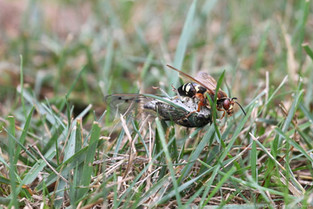Cicada Killer Wasp vs Asian Giant Hornet-What's the Difference?
- Danielle Fornal
- Aug 1, 2020
- 2 min read
Larger stinging insects such as the Cicada killer wasp may be easily mistaken as the media-hyped Asian Giant "murder" hornet, but as you'll read below, there is quite a difference between the two.
The Cicada Killer Wasp
The cicada killer is not nearly aggressive as the Asian giant hornet, to honeybees or to humans and pets alike. They are a solitary wasp that look like an over-sized, paler version of a yellow jacket. Where does that scary-sounding name come from? Well, the name is actually quite fitting, as female cicada killer wasps locate cicadas and paralyze them by stinging them and then place the paralyzed cicadas in each burrow and then deposit an egg in each burrow.
Cicada killer wasp females create burrows usually where full sunlight is present. A common place for a burrow is bare soil, such as close to sidewalks, in flower beds or beneath shrubs.
Cicada killer wasps are up to 1 1/2 inch in length. Males are usually smaller compared to females. They are dark brown to black in color, with colorful yellow markings on several segments of their abdomen. Their wings are reddish-orange.
Only female cicada killers sting.
The Asian Giant Hornet
Regardless of the social media hype and shady web articles, experts consistently state that the Asian giant hornet is not particularly hostile toward humans and pets, but is a significant predator of honeybees.
Asian giant hornets are social insects and maintain underground colonies with one queen and multiple workers. They are the world’s largest hornet, measuring 1.5 – 2 inches in length. They carry around a large orange or yellow head and prominent eyes. They have a black and yellow striped abdomen.
The Asian giant hornet's nest is hard to locate. They are often formed in pre-existing holes in the ground (such as a rodent's nest) or in hollowed tree trunks or dead tree roots.
As social insects, they have the ability to carry out coordinated attacks against the nests of other stinging insects. In other words, they will massacre and occupy the nests of paper wasps, yellow jackets, and as well-stated in the media, honeybees.
The hornet was first detected in North America in December 2019 when a Washington resident found a large, dead hornet. The hornet was confirmed to be an Asian giant hornet. Thankfully, the United States Department of Agriculture, the Washington State Department of Agriculture and local universities have begun work to educate, locate and report, and eradicate the pest before it becomes established.
If you find nests around your home, contact a licensed pest professional to deal with any active nests in a safe manner.














댓글